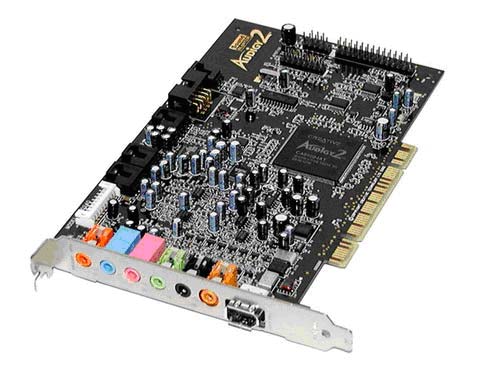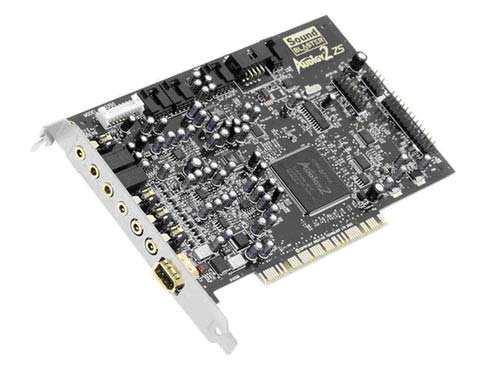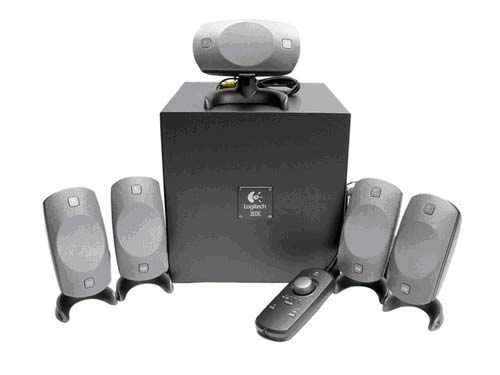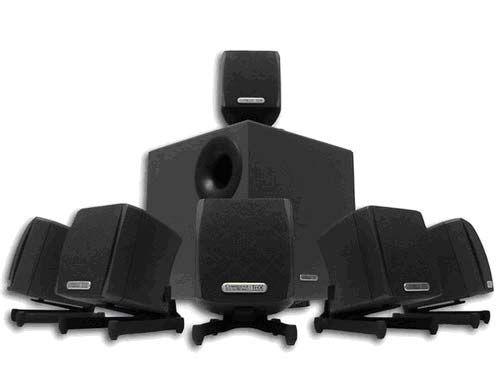Buyer's Guide: High End System - May 2004
by Wesley Fink on May 26, 2004 11:00 AM EST- Posted in
- Guides
Sound Card
Recommendation: Creative Labs Sound Blaster Audigy 2 (6.1) OEMPrice: $71

Since many of the packages that come with sound cards add a lot to the cost and little to the value, an OEM version of an Audigy 2 sound card provides the best value for a high-end sound card. If you're a big gamer, love watching movies, or are just someone who wants quality sound, the Audigy 2 is one of the best on the market to fit those needs. This version of the Audigy 2 supports 6 channels of sound and will deliver a great listening experience in any game, and especially ones that support the Audigy 2's special features like EAX. Simply pair the Audigy 2 with the right set of speakers and you'll have the necessary tools for an exceptional listening experience. Other special Audigy 2 features include 24/96 analog playback and recording and "add-ons" like FireWire.
Alternative: Creative Labs Sound Blaster Audigy 2 ZS (7.1) retail
Price: $83

The Audigy 2 ZS differs from the regular OEM Audigy 2 mainly in its support of 7.1 channels of sound instead of 6.1 The benefit of going to 7.1 isn't really all that huge, as there's a point that you reach where continually adding more channels yields diminishing returns; that is, your surround sound experience doesn't get a whole lot better going from 6.1 to 7.1 channels, or for that matter, 5.1 to 7.1 channels, depending on how sensitive your ears are. The Audigy 2 ZS is also a retail package instead of OEM, meaning you get additional bundled features, such as video games and a FireWire header.
As we've said before, there are inevitably going to be people who don't need this kind of audio processing power. For those users, we simply suggest that you use your motherboard's onboard sound controller. Some people could care less about their system's sound as long as there isn't any interference or crackling. If that description fits you to a tee, then use the onboard sound controller and forget about the Audigy 2.
Speakers
Recommendation: Logitech Z5300 THX Certified 5.1 speakersPrice: $146 shipped

Logitech, yet again, tops our speaker recommendation this week with their popular Z5300 5.1 THX Certified speaker system. Besides obviously supporting 5.1 channels of sound, the Z5300 is able to boast such features as a 100W subwoofer and a greater than 85 dB signal to noise ratio. The surround sound gaming and movie experience is tremendous, especially paired with a good Audigy 2 sound card. These speakers can also get impressively loud, and best of all, we didn't encounter any sort of crackling or distortion as volume was turned up to excruciatingly loud levels. For the price, these speakers are unbeatable.
Alternative: Creative Labs Megaworks THX Certified 6.1 speakers
Price: $248 shipped

This speaker system justifies its value versus the Logitech Z5300 speakers with:
- 6.1 surround sound instead of 5.1 surround;
- 99 dB signal to noise ratio instead of "somewhere" over 85 dB;
- 150W subwoofer instead of 100W subwoofer;
- 70W per satellite and 75W for the center instead of 35W and 39W center; and,
- Positional audio support.
If, for whatever reason, you're not interested in high end sound and will be gaming or watching movies mostly with your headphones on, obviously an expensive surround sound system will be pretty useless. If that's the case, you may just want to opt for 2.0 or 2.1 speakers, such as the ones recommended in our last Entry Level Buyer's Guide.
If you cannot find the lowest prices on the products that we've recommended on this page, it's because we don't list some of them in our RealTime pricing engine. Until we do, we suggest that you do an independent search online at the various vendors' web sites. Just pick and choose where you want to buy your products by looking for a vendor located under the "Vendor" heading.










59 Comments
View All Comments
Pumpkinierre - Wednesday, May 26, 2004 - link
At first, I was shocked at your choice of FX53 as a cpu because this is the last of the Sckt940 FX and upgradeability to later FXs would not be possible. Upgrade ability is not one of your criteria but it certainly is mine as I expect an expensive mobo to span two generations of cpus, video cards and even memory. But really Skt940 is more trustworthy (and possibly cheaper) than even 939 as other posts point out because it is the server cpu-opteron. So the mobo might handle the dual core opterons next year. After this revelation I thought the FX51 might cut a few dollars but your price list has it $20 MORE than its bigger brother! AMD go figure?!The FX is still a rip-off and the new Skt 939 3800+ looks like its got a lot of grunt, according to the french article below, but runs hot (104Watts, 50-60C) and this is 130nm- Prescott anyone?:
http://www.x86-secret.com/popups/articleswindow.ph...
They only found 0-5% increase with dual channel for same speed cpu and it had problems with four dimms- dropped to 2T timing or to DDR333 with DS modules. And the price may be expensive with AMDs habit of selective release from the high end like previous a64s:
http://www.overclockers.com/tips00588/
With the Skt478 P4 you're limited as an upgrade to P4EEs coming down in price unless 3.6 N'wood or Prescott skt478 appears (which is hardly worth while anyway)- neither of which is likely.
So the Sckt940 is not a bad option. If only those FXs would drop into the $500 range.
SHO235V8 - Wednesday, May 26, 2004 - link
I agree that there seems to be a huge spread, but I also assume it will be adjusted in the next mid level guide. I too have been waiting for the 939 boards, but I may not wait much longer considering VagrantZero's points regarding new M/B technologies and DDR2 which will be commonplace by the time I upgrade in a year or two. Besides, there are sometimes issues with the first release version of new technologies. Anyone else know of a better reason to hold off for the new boards? Will dual channel memory be that much faster?Dismal - Wednesday, May 26, 2004 - link
I was a little scared at first that the non-FX Athlon 64's would be completely forgotten about when opening the guide. But I was glad to see some mentioning in there. Hopefully they will still stay in the guides. I want good performance but I just can't spend the kind of cash to buy an FX. Recommendations in the mid-range guide don't seem to fit the kind of performance I'm looking for either. (I agree with rdclark's post above about the gap between mid-range and high-end). I don't think I'm savvy enough to go with overclocking. The price of the Athlon 64 3400+ seemed to be a good match for me. Hopefully they'll still remain in the guides.JKing76 - Wednesday, May 26, 2004 - link
Aluminum cases don't dissipate heat any faster than steel.Locutus4657 - Wednesday, May 26, 2004 - link
Well I have to say, you did finally remove one of my biggest bet peives with these guides. I never could understand why Evan kept recommending 120GB drives for a high end system, Personally I'm considering getting 160GB for my system, and right now I just have an entry level computer ( AXP 2200+ ). One can never have enough hard drive space!GokieKS - Wednesday, May 26, 2004 - link
Great choices, and it's nice to finally have a truly good case being recommend. But since there's still such a big part of the $5K budget remaining, why not something even more high-end, like the SilverStone SST-TJ03 Nimiz? ;)The 193P is an excellent monitor, no doubt, but as one of the 19" LCDs limited by a 1280x1024 resolution, the extra $150 or $200 of the Viewsonic VP201 is definitely worth it. And if you have two of them... ^^
Other than that, just about everything seems fine, even if I personally would go for the A64 3200/3400 instead of the FX53, and pair it up with a nForce3 250Gb mobo.
~KS
Da3dalus - Wednesday, May 26, 2004 - link
Seems like good choices. The only thing I'd choose differently would be the case and the alternative 200GB HD, I'd choose the S-ATA version of that instead of the IDE version. The price difference is really tiny and S-ATA is just plain nicer (I hate those big IDE cables).rdclark - Wednesday, May 26, 2004 - link
I'd like to see some performance benchmarking of these systems, especially as this high-end guide's system costs a cool thousand more than the previous high-end guide's. How much of a difference is there, or are you just buying expensive bragging rights?The new guide also leaves a fairly large gap between the mid-range and the high-end system; the mid-range is still suggesting an XP2800+, while this jumps right to the highest of the high-end. That removes a valuable basis for comparision (and decision-making) in the Athlon 64 3xxx space, which (IMO) seriously lowers the value of these guides.
cosmotic - Wednesday, May 26, 2004 - link
Why not reccomend the DDW-082 instead of the DDW-081?VagrantZero - Wednesday, May 26, 2004 - link
I wouldn't rec you getting 2gb of ram. There's nothing [aka games] out there that uses it, not even D3 or HL2. I doubt 2gigs will really become a good thing until U3 [2006] and by then DDR2 should be coming into its own making your DDR obsolete. I'd say save $300 and get a 3400+/3700+. From x86's article [foreign website, here's the translated url http://translate.google.com/translate?u=http%3A%2F...] the 754 3400+ was outperforming the 939 3500+ in the majority of benchs. I'll wait and see how the 3700 handles the 3800, but if it wins I'm sticking with the old socket [I'd have to upgrade my mobo eventually anyways thanks to PCI-E, SATA300, and DDR2 so 939 isn't anymore future proof for me than 754]. Plus there was talk of 104W power requirments [THAT'S MORE THAN THE PRESCOTT!] and that the new socket chips ran almost as hot as intel offerings. It's just one article so take it with a grain of salt, but I have my suspicions.Also, if you don't plan to OC Corsair XMSPC3500s would be a great pick.